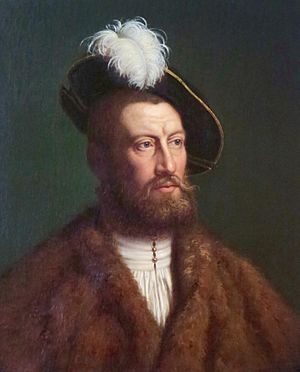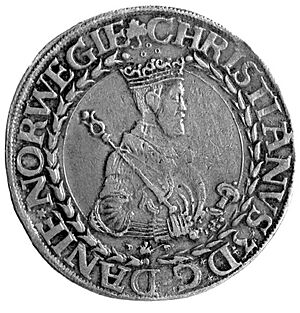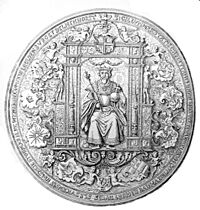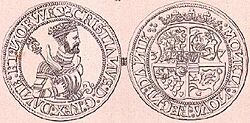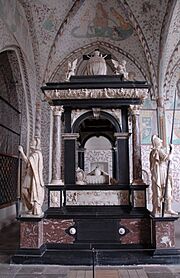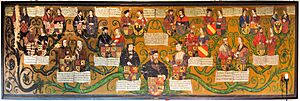Christian III of Denmark facts for kids
Quick facts for kids Christian III |
|
|---|---|
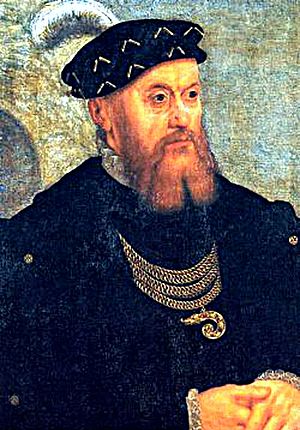
Portrait by Jakob Binck, 1550
|
|
| King of Denmark (more...) | |
| Reign | 4 July 1534 – 1 January 1559 |
| Coronation | 12 August 1537 Copenhagen Cathedral |
| Predecessor | Frederick I |
| Successor | Frederick II |
| King of Norway | |
| Reign | 1537–1559 |
| Coronation | 12 August 1537, Copenhagen |
| Predecessor | Frederick I |
| Successor | Frederick II |
| Duke of Schleswig-Holstein | |
| Reign | 1533 – 10 April 1559 |
| Predecessor | Frederik of Denmark |
| Successor | Frederick II |
| Born | 12 August 1503 Gottorf Castle, Schleswig, Denmark (now Germany) |
| Died | 1 January 1559 (aged 55) Koldinghus, Kolding, Denmark |
| Burial | Roskilde Cathedral, Zealand, Denmark |
| Spouse | |
| Issue | Anna, Electress of Saxony Frederick II, King of Denmark and Norway Magnus, Duke of Holstein John II, Duke of Schleswig-Holstein-Sonderburg Dorothea, Duchess of Brunswick-Lüneburg |
| House | Oldenburg |
| Father | Frederick I of Denmark |
| Mother | Anna of Brandenburg |
| Religion | Lutheran |
| Signature | |
Christian III (12 August 1503 – 1 January 1559) reigned as King of Denmark from 1534 and King of Norway from 1537 until his death in 1559. During his reign, Christian formed close ties between the church and the crown. He established Lutheranism as the state religion within his realms as part of the Protestant Reformation, and was the first King of Denmark-Norway.
Contents
Childhood
Christian was the eldest son of the future king, Frederick I of Denmark, and Anna of Brandenburg. He was born at Gottorf Castle in Schleswig which Frederick I had made as a primary residence. In 1514, when he was just ten years old, Christian's mother died. Four years later, his father remarried to Sophie of Pomerania (1498–1568). In 1523, Frederick I was elected King of Denmark in the place of his nephew, Christian II. The young Prince Christian's first public service after his father became king was gaining the submission of Copenhagen, which stood firm for the fugitive, Christian II. As stadtholder of the Duchies of Holstein and Schleswig in 1526, and as viceroy of Norway in 1529, Christian III displayed considerable administrative ability.
Religious views
Christian's earliest teacher, Wolfgang von Utenhof (ca. 1495–1542) and his Lutheran tutor, the military general Johann Rantzau (1492–1565), were both zealous reformers who had an influence on the young Prince. At their urging, while traveling in Germany in 1521, he made himself present at the Diet of Worms to hear Martin Luther speak. Luther's arguments intrigued him. The Prince made no secret of his Lutheran views. His outspokenness brought him into conflict, not only with the Roman Catholic dominated State Council (Rigsraad), but also with his cautious and temporizing father. At his own court at Schleswig, he did his best to introduce the Protestant Reformation, despite the opposition of the bishops. He made the Lutheran Church the State Church of Schleswig-Holstein, with the Church Ordinance of 1528.
Reign as king
Early reign as King of Denmark
After his father's death, in 1533, Christian was proclaimed king of Denmark at an assembly in Rye, a town in eastern Jutland, in 1534. The Rigsraad, dominated by Roman Catholic bishops and nobles, refused to accept Duke Christian as king and turned to Count Christopher of Oldenburg in order to restore Christian II to the Danish throne. Christian II had supported both the Roman Catholics and Protestant Reformers at various times. In opposition to Christian III, Count Christopher was proclaimed regent at the Ringsted Assembly (landsting), and at the Scania Assembly (landsting) on St Liber's Hill (Sankt Libers hög) near Lund Cathedral. This resulted in a two-year civil war, known as the Count's Feud (Grevens Fejde) from 1534 to 1536, between Protestant and Catholic forces.
After the war and coup d'état in Norway
A mutual confidence between a king who had conquered his kingdom and a people who had stood in arms against him was not attainable immediately. The circumstances under which Christian III ascended the throne exposed Denmark to the danger of foreign domination. It was with the help of the gentry of the Germanic duchies that Christian had captured Denmark. Holstein and German noblemen had led his armies and directed his diplomacy. The first six years of Christian III's reign were marked by a contest between the Danish Rigsraadet and the German counsellors, both of whom sought to rule through the king. Though the Danish party won a victory at the outset, by obtaining the insertion in the charter of provisions stipulating that only native-born Danes should fill the highest dignities of the state, the king's German counsellors continued paramount during his early reign.
The triumph of Christian III would eventually bring about an end to Catholic Christianity in Denmark, but Catholics still controlled the Council of State. Christian III ordered the arrest of three of the bishops on the State Council by his German mercenaries (12 August 1536). Some Catholic bishops were later executed on his orders.
Christian's debt for the Count's Feud was enormous and confiscating the Church lands (farmed by peasants who had been free from vassalage duties to the nobles) enabled him to pay down the debt to his creditors.
Christian's Protestant policies led Denmark toward the establishment of Lutheranism as the Danish National Church (Folkekirke). This occurred officially on 30 October 1536 when the reconstituted State Council adopted the Lutheran Ordinances designed by German theologian Johannes Bugenhagen (1485–1558), which outlined church organization, liturgy, and accepted religious practice. Monasteries, nunneries, and priories, were closed and the property taken by the crown (see Chronicle of the Expulsion of the Grayfriars). Vast tracts of land were handed out to the king's supporters, the royal land was rapidly expanded from one-sixth of the national land before the religious reform to 60% after the religious reform.
In 1537, Christian's coup d'état in Norway made it a hereditary kingdom in a real union with Denmark that would last until 1814. He also made Lutheranism the state religion in Norway, and on 2 September 1537 he appointed Gjeble Pederssøn as its first Lutheran bishop.
Later reign

The dangers threatening Christian III from Emperor Charles V and other kinsmen of the imprisoned Christian II convinced him of the necessity to lessen the discontent in the land by relying on Danish magnates and nobles. At the High Court (Herredag) of Copenhagen in 1542, the nobility of Denmark voted Christian a twentieth part of all their property to pay off his heavy debt to German mercenaries. The pivot of the foreign policy of Christian III was his alliance with the German Protestant princes and France. This provided a counterpoise to the persistent hostility of Charles V, who was determined to support the hereditary claims of his nieces, the daughters of Christian II, to the Scandinavian kingdoms. War was declared against Charles V in 1542, and, though the German Protestant princes proved faithless allies, the closing of the Sound against Dutch shipping proved such an effective weapon in Christian's hand that the Netherlands compelled Charles V to make peace with Denmark-Norway at the diet of Speyer, on 23 May 1544.
Partition of Holstein and Schleswig
Until this peace, Christian III also ruled the entire Duchies of Holstein and of Schleswig in the name of his then still minor half-brothers John the Elder (Hans den Ældre) and Adolf. They determined their youngest brother Frederick for a career as Diocesan administrator of an ecclesiastical state within the Holy Roman Empire.
In 1544 the elder three brothers partitioned Holstein (a fief of the Holy Roman Empire) and Schleswig (a Danish fief). Following negotiations between the brothers and the Estates of the Realm of the duchies, the revenues of the duchies were divided into three equal shares by assigning the revenues of particular areas and landed estates to each of the three brothers, while other general revenues, such as taxes from towns and customs dues, were levied together but then shared among the brothers. The estates, whose revenues were assigned to the parties, made Holstein and Schleswig look like patchworks, technically inhibiting the emergence of separate new duchies.
Final years
The foreign policy of Christian's later days aimed at preserving the peace established by the Treaty of Speyer (1544). He refused to participate in the Schmalkaldic War of 1546, and mediated between the Emperor and Saxony after the fall of Maurice of Saxony at the Battle of Sievershausen in 1553. In 1549, he began the building of Landskrona Citadel. He also rebuilt Sønderborg Castle, converting it from a fortress into a four-winged castle in the new Renaissance syle, between 1549 and 1557. In February 1555, he interceded successfully on the behalf of the English Bible translator and Bishop of Exeter, Miles Coverdale (1488–1569), who had been imprisoned for two and a half years by the Catholic Mary I. Coverdale was then released and allowed to leave England.
Christian III died on New Year's Day 1559 at Koldinghus, and was interred in Roskilde Cathedral in a funerary monument designed by Flemish sculptor Cornelis Floris de Vriendt (1514–1575).
Memorials
In 1579, Frederick II commissioned Dutch artists to erect a memorial to Christian III at Roskilde Cathedral.
Christian III received an honorary stone at the Walk of Fame at Landskrona which Sweden's Carl XVI Gustaf inaugurated in 2013.
Children
Christian married Dorothea of Saxe-Lauenburg on 29 October 1525 at Lauenburg Castle. She was daughter of Magnus I, Duke of Saxe-Lauenburg and Catherine of Brunswick-Wolfenbüttel. Christian and Dorothea were the parents of five children:
- Anna of Denmark (1532–1585), married to Augustus, Elector of Saxony.
- Frederick II of Denmark (1534–1588), succeeded as King of Denmark and Norway.
- Magnus of Denmark (1540–1583), became Duke of Holstein, and later titular King of Livonia.
- Hans of Denmark (John the Younger; 1545–1622), Duke of Schleswig-Holstein-Sonderburg as 'John II'.
- Dorothea of Denmark (1546–1617), married to William, Duke of Brunswick-Lüneburg and mother of George, Duke of Brunswick-Lüneburg.
Related reading
- Øystein Rian (1997) Danmark-Norge 1380–1814 (Universitetsforlaget) ISBN: 9788200228455
See also
 In Spanish: Cristián III de Dinamarca para niños
In Spanish: Cristián III de Dinamarca para niños


